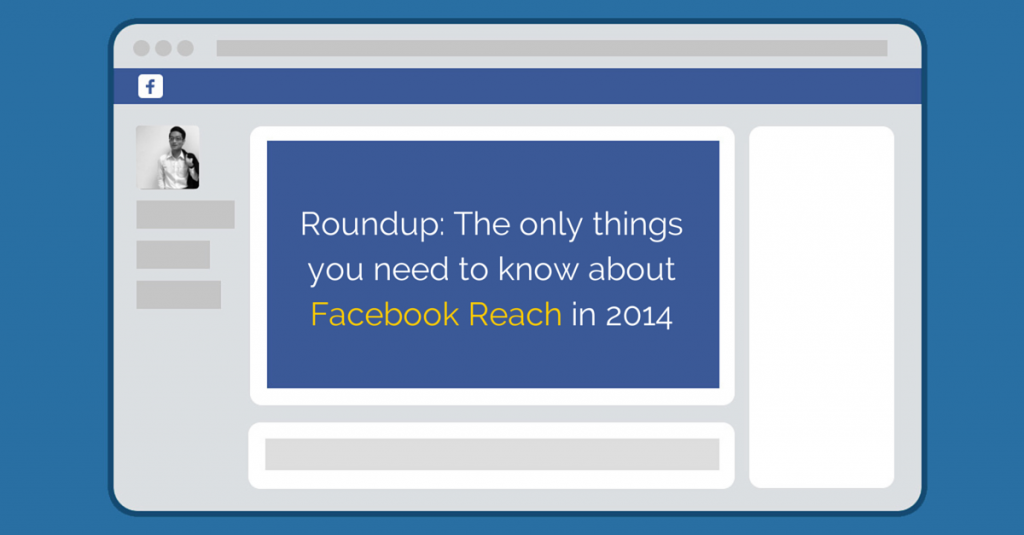The buzz about Facebook reach has finally died down as we progress into the final month of Q3 2014. In case you got lost in all the buzz about Facebook reach, I have put together a succinct summary of what happened and the key opinions about it.
1. The obvious: Reach has declined.
The most brutal fact about Facebook reach is that it has declined. This report by Mark Schaefer and Emeric Eernoult tells us the truth after analysing the numbers behind 8,000 Facebook pages.
Apart from the obvious trend, we’re seeing a wide variation across and within industries. A quick word with some of my colleagues in the industry found that pages with huge fan bases get hit harder by the new algorithmic change than those with small fan bases of less than 10,000.
To see which industries are doing best and worst in terms of average Facebook reach, make sure to check out the article above.
2. But why has reach declined? Facebook explains.
Unless you’ve been living under a rock, you should be aware that thousands of businesses, including big brands, were very unhappy with Facebook for the algorithmic change. Because this became such a huge matter, Facebook could not stay silent and had to explain its stand.
If you missed the official update from Facebook, here is a summary of what they had to say:
There are two main reasons.
The first reason involves a simple fact: More and more content is being created and shared every day. You’ve probably felt this change yourself. Just a few years ago, sharing important moments and experiences, articles you’ve read, and photos and videos of your loved ones was a relatively labor-intensive process. Today, thanks to devices like smartphones, many people can share this content with just a few swipes of the finger or taps of a button.
There is now far more content being made than there is time to absorb it. On average, there are 1,500 stories that could appear in a person’s News Feed each time they log onto Facebook. For people with lots of friends and Page likes, as many as 15,000 potential stories could appear any time they log on.
As a result, competition in News Feed — the place on Facebook where people view content from their family and friends, as well as businesses — is increasing, and it’s becoming harder for any story to gain exposure in News Feed. In addition to the growth in content, people are also liking more Pages. Facebook’s director of product management for News Feed told TechCrunch this April the total number of Pages liked by the typical Facebook user grew more than 50% last year. With each new Page like, competition in News Feed increases even further.
The second reason involves how News Feed works. Rather than showing people all possible content, News Feed is designed to show each person on Facebook the content that’s most relevant to them. Of the 1,500+ stories a person might see whenever they log onto Facebook, News Feed displays approximately 300. To choose which stories to show, News Feed ranks each possible story (from more to less important) by looking at thousands of factors relative to each person.
I won’t explain any further because it is pretty much self-explanatory. But what naysayers think is that this is just another (natural) move to monetise Facebook further, since pages that want to reach more people need to fork out money to reach more people.
In a sense, this is true. In essence, Facebook is reducing your real estate on the newsfeed and making you pay to reach more people. While the ad inventory stays constant or even increases as Facebook attracts more people, the demand for these ad inventory is definitely increasing because of businesses like yours and mine.
3. But..what is a good reach anyway?
Numbers…they are meaningless if we don’t give them one. And how do you know whether 5,000 is a good or bad reach? Even if you were to ask me, I wouldn’t have an answer for you.
I think far too many people look at reach as if it represents revenue. That is simply not true. But some have gone further to suggest that they observe a positive correlation between revenue and reach. This is an interesting suggestion that I am looking out for with my clients as well.
If you have no idea what is a good reach like me, this free tool by Agorapulse might give you a little insight into determining whether your reach is good or bad.
4. So you want to increase your reach?
What if I told you that it is possible to increase your reach, no matter whether it is good or bad right now?
Mari Smith shared 12 handy tips which you can implement right away:
- Post more often - at least three times a day.* (However, you may find your page works better with less – you have to experiment).
- Experiment with posting at different times of the day, including outside business hours.
- Post a mix of your own content (short tips + links to your longer blog posts) + OPC (other people’s content that you curate from a variety of sources). e.g. for Facebook-related content, follow this Interest List with 36.5k+ subscribers!
- Post directly on your Page and also share posts from other relevant Pages.
- Include @ tags of related Pages in your posts. This may help create more visibility in the news feed of the fans who have liked the tagged pages. Don’t over do the @ tags, though, and always remember your etiquette.
- Repost your own evergreen content.
- Mix up the post types: status updates, links, photos, videos, offers, events, milestones and cover image changes.
- Test post length from super short (<120 characters) to much longer (63k is the max!).
- Check your Insights for when your fans are online and be sure to post during these times (as well as outside, per tip #2).
- Consider coming up with a theme for each day of the week and publish posts pertaining to that day’s theme. Also, look for ways to crowd source content and featured input from your fans.
- Compare your reach performance against the average at: http://barometer.agorapulse.com/
- And, of course PAY for more reach on posts that impact your bottom-line, using the Boost post option or go into your Ads Manager/Power Editor.**
Personally, I have tried tips number 2, 5, 7, and 8. I have seen a good amount of success with 2 but not the rest. On the other hand, I am not a fan of 1 and I’ve explained why in this post. But online marketing involves a lot of trial and error so go ahead and try all of them. You might find a few that works well for your page.
5. A more advanced tip to increase Facebook reach - through increasing engagement.
Mike Gingerich wrote an article for Mari a few months back to share with us how we can also increase our page reach. His formula was simple - it was to increase engagement so that the Facebook newsfeed algorithm will favour you.
More importantly, he asked this question, “why are people primarily on Facebook?” Far too many businesses think of Facebook users as easy targets where they are “ready to convert into customers”. This could not be further away from the truth and businesses who act like this are bound to end up in failure.
Perhaps the most handy tip from Mike is to ask these five questions about your audience:
- Would people be interested and comfortable sharing this post?
- Does this help my fans be perceived as funny, helpful, or “in the know”?
- If my fans were to share this post, would it make them look good in the eyes of their friends or fans?
- Am I giving my audience something of value to pass on?
- Would I stop while scanning the news feed to check this out?
Save these questions to a simple checklist and ask yourself each time you’re posting something on your page. Observe your results after two to four weeks of consistent effort and let me know if you see any upward changes.
6. What if reach is still low and you’re not willing to pay?
Perhaps I am not supposed to say this since a lot of the work I do involves Facebook. But a number of big brands are consciously moving away from Facebook and social networks in general towards microsites (which are not new), where they can exert absolute control.
Part of the problem and argument against social networks has always been the fact that you do not own them and you are only marketing on rented land. And that is a fact that I embrace. In fact, that is why I have never advised any client to build their online presence solely on Facebook or another social network. It’s not just dangerous, it’s also irresponsible.
7. Is low reach a big problem or is there a way around it?
You made it.
So far, I have been talking along the lines of increasing Facebook reach and moving away from Facebook if all does not work out. But the key thing about the stuff you read here has always been a different perspective, and that is exactly what I’m going to offer.
What if low reach is not a problem at all? We keep obsessing about reach as if our business would end tomorrow without it. That could be true if your business depends solely on Facebook and I would have given you a lecture if you were my client.
But the true gist of this entire idea of social media as a marketing tool has always been about building a highly engaged and relevant community that is ready to convert. Look - no where in that description did we talk about a big or huge community.
So instead of thinking at the micro-level about Facebook reach, perhaps you can figure how you can increase the value of your social media community. One way that I’d recommend you to do so is to sync your social media and email marketing efforts.
If this sounds interesting to you, then you should definitely check out this post on Socialmouths. I absolutely love it.
How about you?
Have you gotten over reach? Or have you seen success with your page despite the fall in reach? Share your valuable experiences with me in the comments below!


